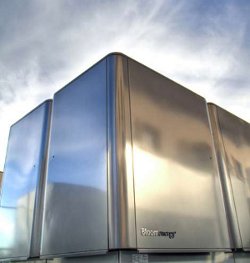Have you heard of Bloom Energy? If not, you need to know about it because it’s doing some interesting things, and results are now beginning to show up.
 Bloom Energy made news when it bagged more than a billion dollars in venture capital as a fuel cell startup; since 2011, expectations have been growing that the company would eventually develop past its business model of selling Bloom Energy Servers—in other words, that it owuld get into financing installations via leasing or other power-purchase agreements.
Bloom Energy made news when it bagged more than a billion dollars in venture capital as a fuel cell startup; since 2011, expectations have been growing that the company would eventually develop past its business model of selling Bloom Energy Servers—in other words, that it owuld get into financing installations via leasing or other power-purchase agreements.
Now, Green Tech Media reports that earlier this week, Bank of America Merrill Lynch made a “multi-million-dollar commitment” to finance two projects located in California, partnering with Bloom’s “Bloom Electrons” leasing program. The two projects will be situated at the TaylorMade-Adidas Golf Company factory in Carlsbad and the Honda Center at Anaheim.
From the press release:
“Bank of America Merrill Lynch has been a leader in providing capital and investment solutions for clean energy deployment,” said Bill Kurtz, Chief Financial & Commercial Officer of Bloom Energy. “This program demonstrates the value in Bloom’s technology for customers and organizations looking for ways to invest and support the transition to a clean energy future.”
While explicit details are not yet available, it appears the deal forms part of Bank of America’s (NYSE: BAC) environmental business initiative, which is estimated at around $50 billion. The press release quotes Paul Omohundro, head of BofA Merrill’s Global Vendor Finance:
“Our company has a long history of supporting innovation in energy and developing financing mechanisms to make clean energy more accessible. This program extends the impact of the bank’s commitment to focusing on environmental issues and empowers other organizations to deploy clean energy on a large scale.”
The benefit of the Bloom Electrons program is that it reduces the burden of upfront capital investment for consumers who want fuel cell-based electricity. Under the agreement, customers instead purchase power at a specified price for a certain period of time, but they do not have complete ownership of the power source.
Bloom, for its part, partners with third-party financiers in order to translate those customer payments into a long-term return on its investment. These third parties officially own the “Bloom Boxes” and accordingly are entitled to incentives on them, like carbon emissions credits, clean energy rebates, subsidies, and so on.
Back when Bloom launched in 2011, it already claimed customers like the California Institute of Technology, Becton, Dickinson and Co., and Kaiser Permanente. The latter has, in fact, stated that it will order 4 MW of fuel-cells from Bloom.
More recently, AT&T (NYSE: T) became Bloom’s biggest customer with a 17.1 MW order total. And that’s not all; Bloom has even paired up with Japan’s SoftBank in a $10 million joint venture.
It’s expected that Bloom could become profitable this year, and the company has been mulling over an IPO. However, the Bloom model’s overt reliance on government subsidies has elicited some criticism—which is a fair point. After all, what will Bloom do once these subsidies (which are designed to help get alternative business sectors off the ground, but then are typically wound down) are eliminated?
Our analysts have traveled the world over, dedicated to finding the best and most profitable investments in the global energy markets. All you have to do to join our Energy and Capital investment community is sign up for the daily newsletter below.
Fuel Cell Power and the Rise of Leasing Programs
Fuel cell electricity has become a heated topic in recent times. The basic idea involves large boxes that generate power through chemical reactions instead of combustion—in short, oversized batteries. In Bloom’s case, the chemical reaction consists of natural gas or biogas being passed over catalyzed plates, which then generates electricity.
The advantages of the fuel cell model are obvious; power can be produced on-site, and facilities powered by these systems can operate independent of the general power grid. And, of course, the power itself is much cleaner due to the minimized carbon footprint.
As GigaOm notes, leasing models appear to be a signature move of alternative energy operators. Recently, Tesla Motors (NASDAQ: TSLA) unveiled its version of a leasing program for the highly-successful Model S electric car.
Leasing programs tend to reduce the initial cost to consumers, thereby promoting availability and growing the potential customer base. Both in the case of electric cars and in the case of Bloom’s service, high upfront cost is a stumbling block. Such leasing programs can ease the transition greatly.
If you’re looking to get involved with Bloom, you could either wait until the company unveils its IPO (which should be in the near future), or you could try getting in via its current customer roster.
If you liked this article, you may also enjoy:


